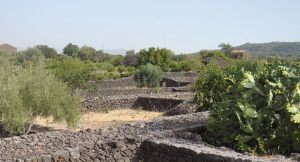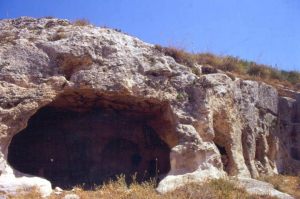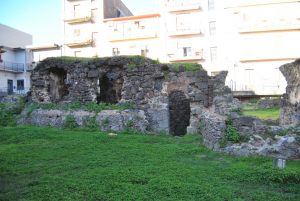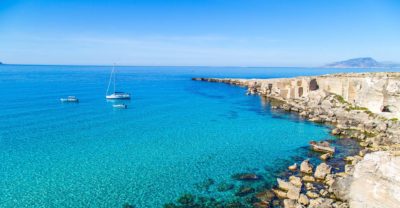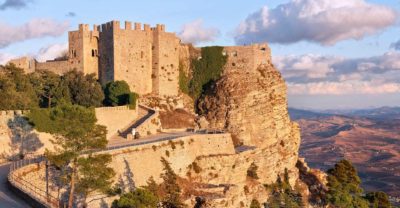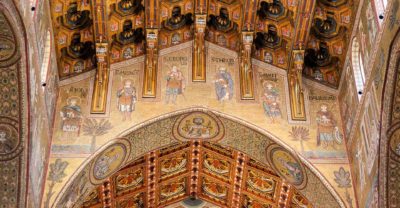Archeological sites
Catania
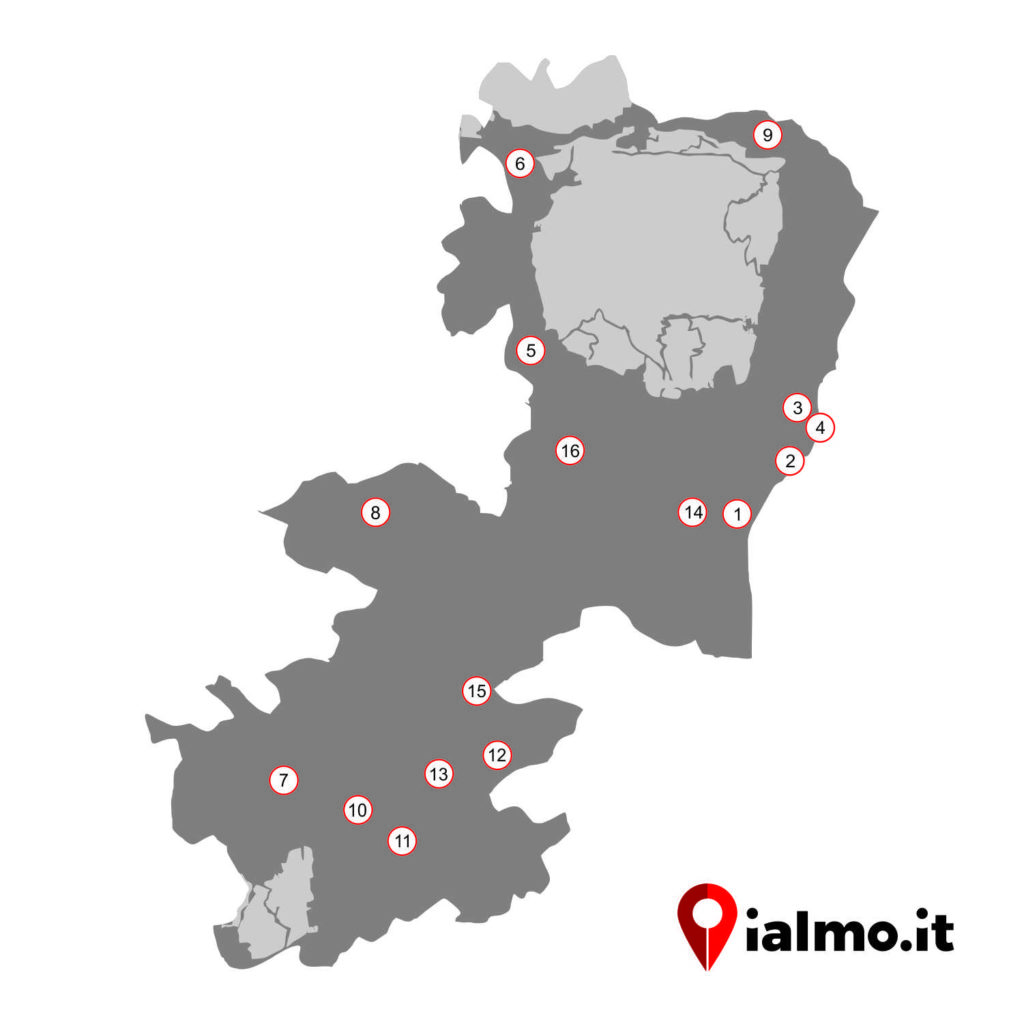
- The Roman Amphitheater, datable to the second century, was buried until the eighteenth century, when the Prince of Biscari encouraged the excavations, and today you can visit a small part near Piazza Stesicoro. It is hypothesized that it was one of the largest amphitheatres in Sicily, with a capacity of over twenty thousand people and was built entirely with the lava stone of the volcano then covered with marble. According to some sources it seems to be the theater of the Naumachie, that is the naval battles that took place after the complete filling with water. On an architrave the inscription Amphitheatrum Insigne imprinted in the stone is still visible.
- The Roman Aqueduct ran through many countries in the Etna hinterland and its dating is attestable to the age of Augustus thanks to the discovery of an inscription on a plaque showing the names of the Curatores aquarum, slab still visible today at the Museum of Castello Ursino. According to the writings of the Prince of Biscari, the structure suffered several damages, first of all due to the lava eruption of 253. It soon fell into disuse, especially after the volcanic eruption of 1669 that covered it for the most part, with the exception of some fragments visible in the neighboring municipal territories.
- Roman Forum: of the structure there are only a few fragments visible inside the courtyard of San Pantaleone. Originally it was made up of several buildings with the function of warehouse that surrounded a central area, the forum for the note. Today we can see the remains of an entrance arch, some adjacent rooms and the remains of a wall in opus reticulatum, a building technique typical of the Roman period.
- Terme Achilliane: this is the thermal structure built in the city around the 5th century BC and of which only a few portions remain in the underground part of the Cathedral. The dating is certain and attested by an inscription on a stone visible at the Museum of Castello Ursino. Today you can visit a part of the Tepidarium, an area designed for relaxation thanks to the heating of the air recreated with hot water basins and canalization systems and a part of the Frigidarium composed of some tanks used for channeling and cooling the water. The whole area was decorated with stuccos, still perfectly observable in the eighteenth century and which today are largely faded.
- Roman mausoleum of Carmine: it was built in the 2nd century AD in an area with a necropolis function. The building is now located inside the former Convent of Carmine and is accessible to the public. For years it was erroneously attributed to the tomb of Stesicoro on the basis of the studies of Libertini then denied by the historians who succeeded him. The structure was built with the technique of the opus coementicium, ie the use, typical in Roman times, of cement mixed with gravel and gravel. The interior has a single room and had a vaulted ceiling and side openings with lighting functions. The excavations of the last years carried out around the area have brought to light the presence of an adjacent funerary monument placed in a lower position than this.
- Roman Theater: popular tradition identifies it as the Greek theater but its recognition has been doubtful and not very clear for centuries. Over the centuries the area has been the subject of renovations and extensions: Augustus reconstructed the curtain by replacing the original sandstone with lava stone, Emperor Hadrian embellished the interior with inscriptions, statues, bas-reliefs and plinths depicting victories on the barbarians and with a proscenium covered in marble. After the fall of the Empire, the structure was abandoned to be used in the period of the High Middle Ages as a warehouse and for civil homes.
- Odeon: these are the remains of a smaller theater compared to the larger one adjacent to it. It is hypothesized that it was used for the rehearsals of the shows that were held in the main theater. According to the reconstructions he had the classic semicircular shape and could hold about 2,000 spectators.
- Necropolis: the sepulchral area, dated around the 4th century BC, comprised the peripheral part of the city outside the Gate of Jaci. Many remains of funerary monuments, among them also the urns with the inscription of the names in Latin.
- Hypogeum Modica: this is the circular-shaped mausoleum of Villa Modica, probably structured on two floors of which only the lower one is composed of four arched niches for burial. Few remains can be glimpsed of the terracotta frame that marked the passage between the two levels.
- Hypogeum Square: it is a sepulcher of the imperial age referable to the II century AD It can be visited in the former garden of the convent of Santa Maria di Gesù. What remains is a rectangular structure built partly with the technique of the coementicium and partly with that of the opus incertum. The western part of the building is formed by a square room originally covered with a barrel vault, including niches and a rectangular cell. In the Middle Ages the structure was used for the burial of the monks of the convent.
- Terme dell’Indirizzo: it is a structure incorporated by a religious building, specifically the Carmelite convent of Santa Maria dell’Indirizzo. Of the original building you can visit a dozen rooms, among which we can recognize the calidarium and the frigidarium, as well as a large room with an octagonal base covered by a dome. In the basement ducts were built for the transit of hot air. The dating is around the second century AD.
- Stipe Votiva of Piazza San Francesco: in the Sixties during the excavations for the city’s sewer system, a series of fragments of ceramics donated to the goddess Demetra were brought to light. The remains can be dated from the 7th to the 4th century BC and include cups, vases, figurines depicting the goddess and dishes.
Greek-Hellenistic necropolis, Aci Castello: it was brought to light in the fifties during the excavations for the construction of a school. The sources attest that this is a sepulchral area used since the Bronze Age. The findings consist of a few fragments of bowls, a small head of deities, some skylights and two containers for colored hosts.
Archaeological Park and Thermal Baths of Santa Venera al Pozzo, Aci Catena-Acireale: the Archaeological Park of the Valle dell’Aci is a site of considerable importance that has as its fulcrum the archaeological area of Santa Venera al Pozzo. The area belongs to the municipality of Aci Catena, but it is actually located on the border with the Acese territory, so much so that the sulphurous spring that finds its origin is used by modern Acis thermal baths. According to popular tradition in this place Santa Venera was beheaded during the period of Christian persecution and his head was thrown into the well. The park currently includes nine hectares of land where you can see the remains of a Roman baths built with different environments connected to each other (Tepidarium, Frigidarium, Calidarium), the well for water supply and some furnaces used for the production of ceramics and pottery. In the area of the Baths, the remains of a small temple dedicated to the goddess Venus, fragments of a mosaic and an outdoor pool used as a swimming pool or fish farm have also been found. Not far from the baths, one can note the presence of a building, datable to 280 BC, used in the IV century AD. as a ceramics production industry: inside its rooms, in fact, the excavations have brought to light fragments of tanks, earthenware objects, vases with red paint and amphorae as well as several coins belonging to different periods, from the Greek-Hellenistic one , to the Roman one up to the Byzantine and medieval one.
Roman Temple of Capo Mulini, Acireale: near the seaside village of Capo Mulini, a hamlet of Acireale, it is possible to visit the remains of a Roman temple dating back to the 1st century AD.
Sicilian town of Mendolito, Adrano: The remains of the Sicilian town of Mendolito, which developed a highly refined bronze civilization, were found eight kilometers from today’s Adrano. The city impresses above all for its great extension (eighty hectares) and beyond the walls, the doors and the traces of huts, it also presents a necropolis with characteristic domed tombs. The settlement was already known to Vito Amico since the eighteenth century and yet the importance of the place was revealed to scholars only at the end of the nineteenth century and in the first decades of the twentieth century. From the Mendolito area comes the famous Efebo, a bronze statuette depicting a banquet, a small masterpiece of the Archaic age (530 BC) and the famous sandstone block, now preserved in the Regional Archaeological Museum Paolo Orsi of Syracuse, bearing the longest and important Sicilian text so far known, still of controversial interpretation and datable to the second half of the sixth century BC In addition to the city of Mendolito, there are also numerous other important archaeological sites identified in the territory of the municipality. The Greek polis founded by Dionigi the Elder in 400 BC was located near Contrada Buglio. Imposing are the remains of the boundary wall and the citadel where the excavations have highlighted, among other things, a house with a valuable floor.
There are numerous archaeological sites in the area between Bronte, Maletto and Maniace. Of particular importance are some sepulchral cellars dating back to the Sicels, who were driven from Catania by the Greeks and settled on the western side of Etna. Of this presence, in addition to the famous city of Mendolito, located between Bronte and Adrano and along the course of the Simeto, there are numerous sepulchral cells scattered throughout the territory. Noteworthy are also the Caves called Saracena, located a short distance from Nelson Castle; the nearby remains of the ancient city of Maniace and the site of the Tartaraci district with its settlements and necropolises of the Greek and Roman age.
- The excavations of Sant’Ippolito are located about 4 km north-east from the modern town. The presence of artefacts, known since the nineteenth century, solicited the excavations conducted by Paolo Orsi in 1928. These revealed the presence of two villages of the Neolithic and Chalcolithic period and were also found housing traces dating back to the seventh century BC, era of arrival in the area of Greek colonization. The Neolithic village, found on a plateau of the eastern slope, lapped by a small stream, returned funds of huts, remains of hearths, fragments of axes and arrowheads in stone, ceramic fragments of the type called Stentinello, decorated with simple geometric patterns engraved or embossed. The necropolis of the village included some oven-shaped tombs, dug on the slope on the opposite side of the stream. On the top of the hill, in the Copper Age, a second village was built, more extensive than the previous one, which seems to have remained active until the Iron Age. The archaeologist Luigi Bernabò Brea has been identified as a cultural facies dating back to between 2,000 and 1,800 BC, which would have preceded that of Castelluccio and had relations with the Aegean and Anatolian world. The site has returned a typical ceramic production of Sant’Ippolito, painted with lines and triangles in dark color on a reddish-yellow background. The findings of the site are kept in the Paolo Orsi Regional Archaeological Museum in Syracuse, in Caltagirone at the Ceramics Museum and in the archaeological section of the Civic Museums.
- Monte San Mauro is an archaeological site located southwest of the city of Caltagirone. It includes five hills arranged in a fan pattern over the valleys of the rivers Lord and Maroglio, on which an inhabited center of the Bronze Age settled. The indigenous center was occupied at the end of the 7th century BC from Greek colonists dedicated to agriculture and commerce. On the third hill the presence of the acropolis was hypothesised: there is in fact a large building, discovered in 1904 by Paolo Orsi and already existing in the ninth century BC, which was probably a Sicilian princely residence later reused by Greek settlers). Paolo Orsi also identified along the northern and north-western edge of the hill a defensive system consisting of sections of walls interspersed with natural rock. On the top of the hill, elliptical structures have also been found relevant to indigenous dwellings (one dated between the second half of the VIII and the first half of the 7th century BC). On the slopes of the third hill, a residential nucleus of the first half of the 6th century BC was found, of which the destruction of the tyrant of Gela, Hippocrates (between 498 and 482 BC) is hypothesized. There are three necropolis dating back to the VII-VI century BC brought to light in the area.
Archaeological site of Monte Iudica and Monte Turcisi, Castel di Iudica: from the research carried out up to now it can be deduced that the indigenous center of Monte Iudica, already present in the second iron age, had a great expansion in the second half of the 6th century. In addition to the housing settlement, at the foot of the hill a necropolis has been brought to light, characterized by tombs of the “Capuchin” type and dating from the 6th to the 5th century BC. Other important artifacts found there are large pithoi dating back to the classical era, a sarcophagus and a skeleton of a woman with a child, around the 5th century BC. The site of Monte Turcisi is renowned for the presence of a Phrourion, that is a Greek garrison fortified for military purposes and built on top of the Mount with the dual function of control and defense of the surrounding area.
Some archaeological excavations in the San Nicola district, near the Alcantara river, have brought to light graves, millstones, forts and other findings that testify how the whole valley was densely populated in the Neolithic and especially in the Bronze Age. Many caves dug into the sandstone were used as dwellings or tombs, such as those in the Pietra Pizzicata district, where a prehistoric village of the ancient Castiglionis can still be seen, which had to move to the hill of today’s village threatened by other peoples.
Occhiolà Archeological Park, Grammichele: archaeological site where the remains of settlements dating back to the Bronze Age have been found. The visit is structured in paths already defined, immersed in a beautiful natural environment, from which you can observe the findings and take advantage of areas equipped for a break in nature.
Caves of Marineo, Licodia Eubea: from these caves have emerged remains of prehistoric nature such as engravings and graffiti on the walls depicting animals and solar symbology. One of the caves was home to a spring of which even today you can see the mouth in addition to the remains of a sort of channeling of the water. The solar symbols on the walls lead scholars to believe that the site was used for the devotion of the sun (which was typical of the Copper Age). Noteworthy in Licodia Eubea the Castle Santapau, a castle of medieval origin but built on the site where previously was a defense construction of the Byzantine era and the remains of some important necropolis: Necropolis Vigna della Signora (datable to 450 BC), Necropolis of Fossa Quadara (already inhabited in prehistoric times) and the Necropolis of the Piazzisa (dating back to the fifth and fourth centuries BC).
Dosso Tamburaro, Militello in the Val di Catania: archaeological site that houses remains of a settlement of the Copper Age (3rd millennium BC) and of a coeval necropolis with some cockpit tombs.
Piano Casazze, Mineo: the area has been inhabited since ancient times, since the early Bronze Age. Inside it have been found some grotticella tombs typical of the Iron Age, as well as remains of dwellings dating from the Byzantine era and fragments of sacred buildings, probably sanctuaries. Noteworthy in the district Madonna del Piano the Necropolis of Mulino della Badia dating back to the tenth century a. C. and the remains of Castello Ducezio, the fortress that belonged to Ducezio but probably already inhabited previously and where the marriage between Costanza and Federico III of Aragon was held.
Roman Baths, Misterbianco: these are the remains of a Roman aqueduct dated between the 2nd and the 8th century AD C. There is not much information, but it seems plausible that the system served, as well as a spa area, also to channel the waters of the source of Santa Maria di Licodia to the city of Catania. According to some reconstructions made on the finds still visible today, it seems that it was a building of considerable value that had a dressing room and various rooms intended for bathing in cold water (Tiepidarium), warm and warm (Calidarium), all richly decorated with mosaics and marbles. We also point out in Contrada Pezza Mandra a cave inside which remains of human bones have been found, some work tools and hunting tools referable to the Neolithic period.
Hermitage of Santa Febronia, Palagonia: of great value is the hermitage of Santa Febronia, a rupestrian basilica built around the VI / VII century AD. and on whose back wall a semicircle apse is carved that encloses an altar. The apse is embellished with some remains of murals depicting the Christ Pantocrator, the Martyrdom of Santa Febronia, patron saint of the city and Sant’Agata and original sin. The most important painting, however, is found in the apse and represents Christ between the Madonna and an Angel. The hermitage also has a particular “T” ditch, which used to be the colliers used to treat the bodies of dead monks, so as to practice a sort of mummification.
From the area of Pietralunga, near the Simeto, come a series of archaeological finds, especially vases, coins and artifacts. The Roman period also includes an imposing arch, later renovated, and an entire necropolis, discovered in 1990, where a find of exceptional value was found. This is a funeral clay cover from the early Christian era engraved with the Christian signs of fish and the Trinity. There is also no lack of Roman infrastructure, such as an aqueduct that from Santa Maria di Licodia, crossing Paternò, reached the capital of Etna. Probably the aqueduct was built during the Augustan period and therefore should date back to the first century after Christ.
